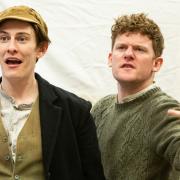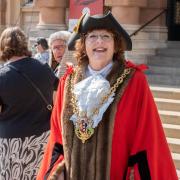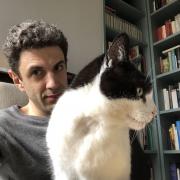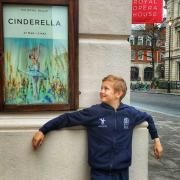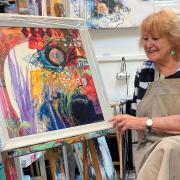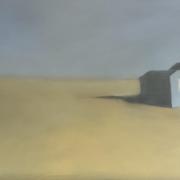'The man who walked by night' was a colourful character who roamed the Suffolk countryside in search of game, but his accounts of his exploits weren't always to be believed, as Carol Twinch explains
'The man who walked by night' was a colourful character who roamed the Suffolk countryside in search of game, but his accounts of his exploits weren’t always to be believed, as Carol Twinch explains
Bungay town lies encircled by the winding River Waveney, surrounded in turn by water meadows and the Broome marshlands where the cattle graze, where river banks are invariably covered by low mists and where the sound of tumbling water in the weir is heard as walkers pass through the kissing gate on their way to the Staithe. This is geography to inspire tales and legends, one of which is the story of poacher and countryman, Frederick Rolfe, who in the early 20th century roamed these parts in search of illicit game. Although Rolfe wrote an account of his exploits I Walked By Night, edited by the famous Bungay resident Lilias Rider Haggard, little was known about this complex character until Charlotte Paton wrote her investigative biography of Rolfe in 2009. Her discoveries are now contained in a recently-released documentary film, The Truth Behind I Walked by Night, by film-maker Peter Hodges.Rolfe lived for a short time at Mettingham before moving to Bungay in around 1918 but it is not known precisely when he began writing his autobiography entitled The Life and History of the King of the Norfolk Poachers Riten by himself. The anonymous manuscript lay unremarked until discovered in the early 1930s by the journalist and writer Lilias Rider Haggard, daughter of the Edwardian adventure novelist and author of She, Henry Rider Haggard, who lived at Ditchingham. Lilias called in to see a local farmer’s wife, Mrs Longrigg, who showed her a dog-eared exercise book given to her by Rolfe when he had worked as a mole catcher on the farm. It was his original memoir, given by Rolfe to Mr Longrigg hoping that it would amuse him. Lilias Rider Haggard saw its potential as a valuable contribution to East Anglian local history, and a rich seam of material for her weekly newspaper column. She sought out Rolfe and persuaded him to write more reminiscences of his colourful life, which she recorded and reproduced in local newspapers and in pieces for Country Life. In May 1934 she persuaded Rolfe to assign all rights to his ‘book of Recollections’ to her for the sum of �20. The book was published the following year with illustrations by Edward Seago who lived in Brooke, a village halfway between Bungay and Norwich.
"Either under the influence of his father, or his more loved grandparents, he developed a deep resentment towards the land-owning classes and began poaching at the tender age of nine"
It was an immediate success and greeted with critical acclaim. Lilias had not, though, delved with any great depth into the truth or otherwise of Rolfe’s account of his life and times, preferring instead to colour the text with nostalgia as befitted her ‘Country Woman’s Week’ column. Frederick Rolfe was born in Norfolk in 1862, a sickly child who was brought up in poverty, his father a farm worker. Either under the influence of his father, or his more loved grandparents, he developed a deep resentment towards the landowning classes and began poaching at the tender age of nine. He did, though, develop a love of reading and writing in his early teenage years, due to the encouragement of the local vicar. He later wrote; “when I get hold of a pen and begin to rite (sic) I feel I can go on just as long as I can hold it”. Thoughts, he continued, writing in his distinctive phonetic fashion, come into his head and he could see again the old faces and places that he had forgotten.But Rolfe had an insatiable need for excitement, which he satisfied by honing his skills as a poacher. He was 20 when he first went to prison and in his book described the daily routine in detail. Lilias Rider Haggard did not condone the crime but she knew the eye witness accounts he gave would be a valuable piece of social history: and so it proved.When, in 2002, Charlotte Paton embarked on her task of discovering the identity of the anonymous author, Rolfe’s book had become a classic of its kind. She had been given a copy many years before by her mother, who thought it might be of interest to her as it was partly about Bungay, where she had grown up and where Rolfe had lived for the last 20 years of his life. Before long she discovered Rolfe’s identity and set about finding out more about the man and his times. Almost immediately she realised that much of what was written was untrue, the author conveniently leaving out the more unsavoury side to his character. The sum of Charlotte’s lengthy and painstaking research was published in her book, The King of the Norfolk Poachers: His Life and Times and now forms the basis of the film.Frederick Rolfe died in 1938, by his own hand, and there are still many living in the town who remember the family. Elsie Treanor, who is Bungay born and bred, remembers Rolfe from her childhood and recalls his bicycle always leaning against the wall of his house in Bridge Street, so that the local police constable would think he was at home and not out in the woods or patrolling the marshes with his rabbit nets and pheasant snares. In the course of his colourful career, Rolfe had at one time been poacher turned gamekeeper but it was the former occupation that caused him to write “if I had my time to come over again I would still be what I have been – a poacher.”Bungay Museum (officially opened in 1963 by Lilias Rider Haggard) not only has Rolfe’s original manuscript, and some of his guns, but during the course of the research curator Christopher Reeve discovered a later document written by Rolfe’s daughter, Emily (by his second wife). Emily married and went to live in Canada but on reading I Walked by Night wrote to Lilias Rider Haggard that she wanted to write her mother’s biography including old songs and snippets of folklore and philosophy, much in the style of her father’s book. She expressed a hope that Lilias would publish it but she never did, though it eventually found its way into the Museum archives greatly adding to the story of Frederick Rolfe, a true countryman albeit with a life story full of contradictions. Legends have grown up around him and I Walked by Night is a classic of its kind. Although he often found himself on the wrong side of the law his writings lend a fascinating dimension to the social and local history of Suffolk.A showing of the film The Truth Behind I Walked by Night takes place at the Fisher Theatre in Bungay on March 23, 2011.
The Truth Behind I Walked by Night is available on DVD, price �15.95, from good bookshops or direct from Old Pond Publishing.





